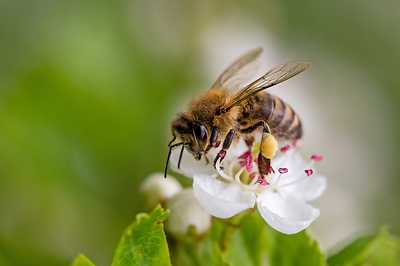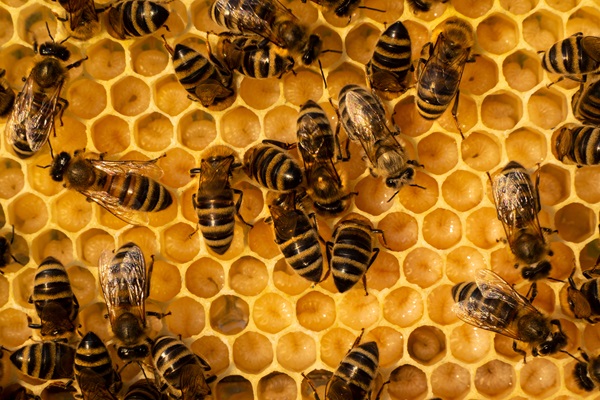The Role of Honey Bees: the One Health Perspective
Presented by the One Health Committee
 Did you realize honey bees (Apis mellifera and A. cerana) can be used to monitor One Health and global impacts especially in regards to climate change, antimicrobial resistance, and environmental pollution such as heavy metals and pesticides? The One Health concept incorporates the juxtaposition of human, animal, agricultural, and environmental health. Antimicrobial resistance is a global threat and one that requires collaborations between diverse scientific and health professions to optimize the delicate matrix of human, animal, flora, and environmental health. Professional societies within the human, veterinary and ecological sciences have implemented preventative stewardship efforts and evidenced-based practice standards to curtail and minimize the risk of antimicrobial resistance.
Did you realize honey bees (Apis mellifera and A. cerana) can be used to monitor One Health and global impacts especially in regards to climate change, antimicrobial resistance, and environmental pollution such as heavy metals and pesticides? The One Health concept incorporates the juxtaposition of human, animal, agricultural, and environmental health. Antimicrobial resistance is a global threat and one that requires collaborations between diverse scientific and health professions to optimize the delicate matrix of human, animal, flora, and environmental health. Professional societies within the human, veterinary and ecological sciences have implemented preventative stewardship efforts and evidenced-based practice standards to curtail and minimize the risk of antimicrobial resistance.
To effectively monitor the impact of antimicrobial use from a One Health perspective, novel and innovative methodologies to monitor impacts on global health and ecosystem are warranted. In these efforts, honey bees serve a unique role for monitoring the environment as they are symbiotically integrated into our global ecosystem and are uniquely sensitive to the effects of climate change, environmental contamination, and antimicrobial resistance. Such factors can reduce honeybee colony health and increase susceptibility to a host of honey bee bacterial, parasitic and viral pathogens leading to colony loss and collapse.
Honey bee immunity is complex and comprised of physical and innate features to encapsulate and sequester bacterial pathogens. In addition, honey bee immunity is linked to the microbiota which can be altered due to antimicrobial resistance, reduced expression of antimicrobial peptides, xenobiotics, pesticides and environmental pollutants. Although adult honey bees are less prone to lethal effects of overt bacterial infections, honey bee larvae are uniquely susceptible or lack appropriate defense mechanisms to the bacterial species Paenibacillus larvae and Melissococcus plutonius especially in the early post hatching time period.
This is complicated by co-infection with Varroa mite infection which not only removes valuable nutrients needed to maintain viability; it can also serve as a vector for several viral diseases. There are only a few select antimicrobials approved for prophylaxis or treatment of bacterial honey bee diseases including oxytetracycline, tylosin, and lincomycin. Veterinary oversight of antibiotic administration to minimize resistance through veterinary feed directives and prescribing practices are important One Health aspects to minimize the development of antimicrobial resistance for honey bee health and the agricultural ecosytem.
Honey bee health is multifaceted and dependent upon internal and external environmental factors. Antimicrobial resistance may be due to horizontal transfer of drug resistance genes between symbiotic microbes or alterations in antimicrobial peptide expression. In addition, the activity of multidrug resistance and cellular membrane transporters may be augmented secondary to pesticide exposure thus stimulating the co-removal of pesticides and antimicrobials leading to lower antimicrobial concentrations at target sites.

Further research is needed to elucidate the effects of antimicrobial resistance upon honey bee microbiota including potential linked effects of pollution, pesticides, and climate change. In these efforts, honeybees can serve as useful One Health bio-monitors within their unique environmental foraging areas due to the collection of pollutants or pathogens within the soil, water, and air. During multiple daily foraging trips and by traveling large distances, honey bees are continually exposed to a variety of xenobiotics and contaminants which collect on their bodies or are ingested during the gathering of pollen, consumption of nectar, or collection of resin and water. The large number of individual bees within a colony allows for very high quantities of combined samples over time. Such containments are concentrated within the hive and can accumulate in honey and beeswax which can be sampled or surveyed for environmental contamination including resistant bacteria, antimicrobial resistance genes, heavy metals, radionucleotides, and pesticides.
Literature review indicates, aromatic hydrocarbons and heavy metals can concentrate in colony hives over time leading to chronic exposure and sublethal impacts to colony health. Furthermore, agricultural chemicals such as herbicides, fungicides, and neonicotinoid insecticides, commonly applied in spring, can concentrate in plants and pollen where bees are exposed during foraging. Although commonly used doses may not lead to acute lethal effects, sublethal, off-target, or chronic effects on honey bee microbiota, hygienic behaviors to remove injured or dead larvae, foraging behaviors, and alterations to immune system function may lead to diminished colony health and are future areas of research focus. Of interest, honey appears to have reduced levels of contamination compared to whole bees most likely due to the bee’s inherent filtering mechanisms within the mouthpart stylet or regional concentration of plant species or variations in the degree of contaminant uptake from soil between plant species. Depending upon geographical region and alternations in environmental factors such as temperature, wind and precipitation, floral and food sources may be diminished thus affecting health and survival of pollinator species. Furthermore, environmental factors such as temperature and geographical variances may affect the quality and strength of natural antimicrobial substances such as propolis thus altering the efficacy of self-medication behaviors within a colony.
Research into the molecular basis for antimicrobial resistance, molecular genetics, or susceptibility factors to environmental contaminants can make controlled studies more challenging as honey bees need free range to forage and sunlight to navigate. Bio-monitoring studies can require several months or years to collect data for regional comparison and may demonstrate seasonal variations. In addition, honey bee foraging activity is linked to climate conditions, zonal flora and geographical preferences thus honey bees may be exposed to a wide variety or very specific environmental contaminants, bacterial species, or pesticides and comparative pollutant reference values may not be available. Co-infections with parasitic, bacterial, and viral pathogens can compound the difficulty in correlating hive morbidity or mortality to select pathogens or contaminate thresholds. However, despite these challenges, honey bees can serve as promising natural biomarkers for overall environmental health and to monitor contamination and bacterial species that may harbor antimicrobial resistance genes or resistant bacteria populations.
In these efforts, additional research monitoring, and standardization to allow for collective participation from beekeepers, scientists, and environmental agencies is warranted. Moreover, with new molecular technologies to detect antimicrobial resistance patterns and to elucidate mechanisms of honey bee immunity, and with innovations in laboratory detection of environmental contaminants and residues, honey bees should be considered as essential for their One Health role in monitoring impacts to the environment and antimicrobial resistance for human, animal, and ecosystem health.
References
• Zapata-Hernández G, Gajardo-Rojas M, Calderón-Seguel M, Muñoz AA, Yáñez KP, Requier F, Fontúrbel FE, Ormeño-Arriagada PI, Arrieta H. Advances and knowledge gaps on climate change impacts on honey bees and beekeeping: A systematic review. Glob Chang Biol. 2024 Mar;30(3):e17219. doi: 10.1111/gcb.17219. PMID: 38450832.
• Foster LJ, Tsvetkov N, McAfee A. Mechanisms of Pathogen and Pesticide Resistance in Honey Bees. Physiology (Bethesda). 2024 Jul 1;39(4):0. doi: 10.1152/physiol.00033.2023. Epub 2024 Feb 27. PMID: 38411571; PMCID: PMC11368521.
• de Jongh EJ, Harper SL, Yamamoto SS, Wright CJ, Wilkinson CW, Ghosh S, Otto SJG. One Health, One Hive: A scoping review of honey bees, climate change, pollutants, and antimicrobial resistance. PLoS One. 2022 Feb 16;17(2):e0242393.
• Resci I, Cilia G. The use of honey bee (Apis mellifera L.) as biological monitors for pathogenic bacteria and antimicrobial resistance: A systematic review. Environ Pollut. 2023 Sep 15;333:122120.
• Mair KS, Irrgeher J, Haluza D. Elucidating the Role of Honey Bees as Biomonitors in Environmental Health Research. Insects. 2023 Nov 14;14(11):874
